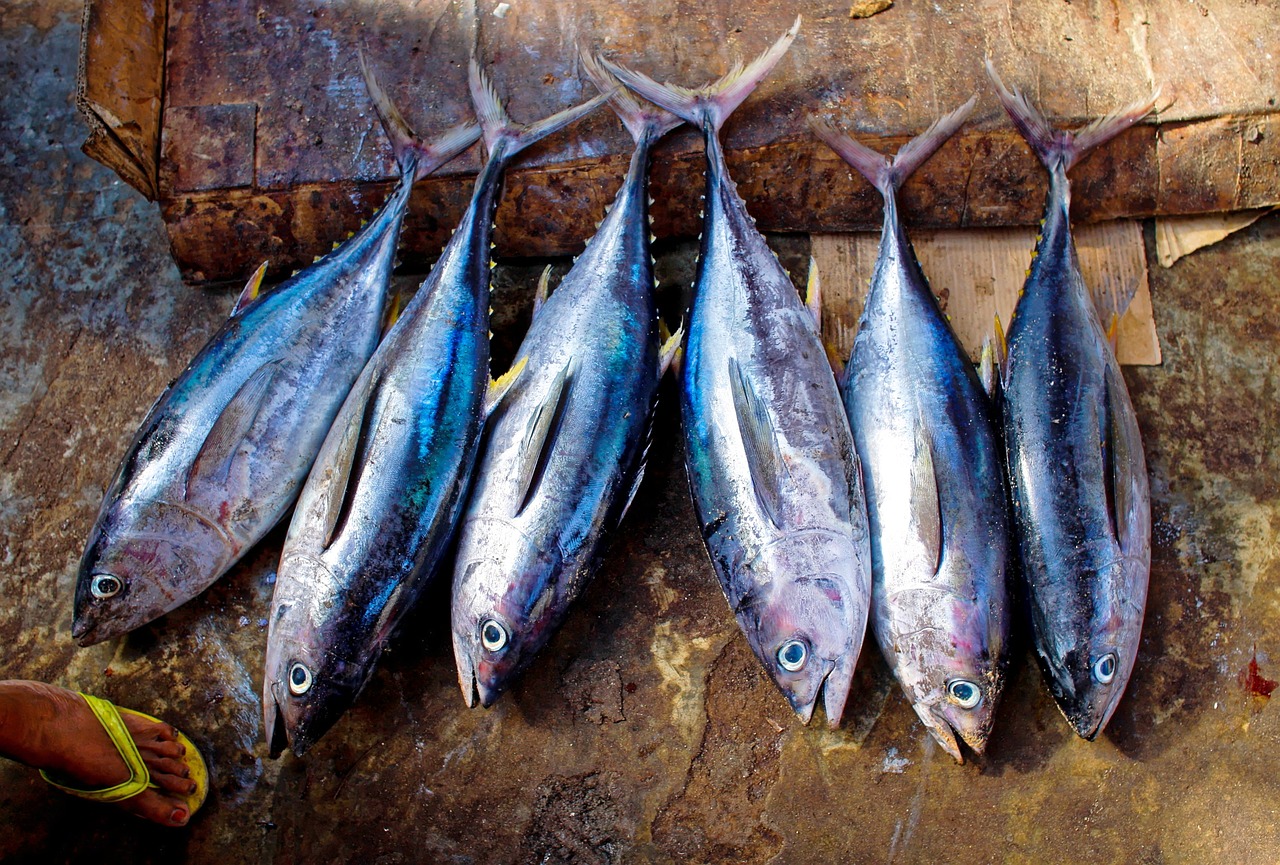- Tuna is a saltwater fish that belongs to the mackerel family.
- It is widely distributed in warm waters around the world, and several species of tuna are commercially important.
- Tuna are known for their streamlined bodies, enabling them to swim at high speeds.
- Some species of tuna, such as the bluefin tuna, can grow to impressive sizes, reaching lengths of over 10 feet and weighing up to 1,000 pounds.
- Tuna have a high metabolic rate, enabling them to maintain their body temperature higher than the surrounding water.
- Tuna are powerful swimmers and can reach speeds of up to 50 miles per hour, allowing them to migrate long distances.
- Tuna are carnivorous and primarily feed on smaller fish, squid, and crustaceans.
- They have a highly developed sense of sight and are capable of detecting prey from great distances.
- Tuna are a popular seafood choice worldwide and are consumed in various forms, including raw in sushi and sashimi, canned, or grilled.
- The Atlantic bluefin tuna is one of the most highly prized species of tuna for its rich flavor and tender flesh.
- Tuna are known for their unique red flesh, which is rich in myoglobin, a protein that allows for efficient oxygen transport.
- Tuna are highly migratory fish and undertake extensive journeys in search of food and spawning grounds.
- Many species of tuna, such as the yellowfin and skipjack, are known for their acrobatic leaps out of the water.
- Tuna are known to form large schools, providing protection against predators and increasing their chances of finding food.
- The fishing industry for tuna is a significant global enterprise, valued in billions of dollars annually.
- Tuna fishing methods vary, ranging from traditional pole-and-line fishing to more modern techniques such as longline fishing and purse seining.
- Tuna are a top predator in the marine food chain, playing a crucial role in maintaining the balance of ocean ecosystems.
- Overfishing and unsustainable fishing practices have led to declining populations of some tuna species, raising concerns about their conservation status.
- Tuna are known for their endurance and can swim long distances without rest, aided by their streamlined bodies and efficient swimming techniques.
- The world record for the largest tuna ever caught by rod and reel stands at 1,496 pounds, caught off the coast of Nova Scotia, Canada.
- Tuna have a lifespan of up to 15 years, depending on the species.
- Tuna are capable of diving to great depths, with some species reaching depths of over 3,000 feet.
- The flesh of tuna is a good source of lean protein, omega-3 fatty acids, and various vitamins and minerals.
- Tuna have a unique respiratory system that allows them to extract oxygen from both air and water, enabling them to survive in low-oxygen environments.
- Tuna have been a subject of cultural significance in various societies and are often associated with strength, speed, and resilience.
- Some species of tuna, such as the albacore tuna, are known for their distinctive long pectoral fins, giving them a sleek and elegant appearance.
- Tuna are highly prized by sport fishermen due to their size, strength, and challenging nature to catch.
- Tuna are susceptible to parasites, such as tapeworms and flukes, which can affect their health and meat quality.
- Tuna have a highly developed sense of smell, allowing them to detect food and navigate over long distances.
- Tuna are able to regulate their body temperature through a process called regional endothermy, where certain parts of their bodies remain warmer than the surrounding water.
- Tuna are capable of quick accelerations, allowing them to chase down fast-swimming prey.
- Tuna are capable of rapid growth, with some species reaching maturity in just a few years.
- Tuna are highly sought after in the sushi market, particularly the fatty toro cut, which is renowned for its rich flavor and melt-in-your-mouth texture.
- Tuna are an important part of many cultural cuisines, such as the Mediterranean diet, where they are used in dishes like grilled tuna steaks and tuna salads.
- Tuna are known to have a unique “tuna oil” scent, which is attributed to the oxidation of unsaturated fatty acids in their flesh.
- Tuna have a well-developed lateral line system, which allows them to detect vibrations and changes in water pressure, helping them navigate and locate prey.
- Tuna are known for their stamina and can swim continuously for long periods without tiring.
- Tuna are highly adaptable to different oceanic conditions, allowing them to inhabit various marine environments worldwide.
- Tuna have a keen sense of hearing and can detect low-frequency sounds, including the movements of other fish.
- Tuna are capable of rapid color changes, which can serve as a form of communication or camouflage in their environment.
- Tuna are known to have a complex and hierarchical social structure within their schools, with dominant individuals asserting their authority.
- Tuna are able to conserve energy by swimming in schools, taking turns to lead and reduce drag for the rest of the group.
- Tuna have a powerful sense of taste and can differentiate between different flavors and food sources.
- Tuna are an important economic resource for many coastal communities, providing income and employment opportunities through fishing and related industries.
- Tuna have been studied extensively by scientists to understand their behavior, migration patterns, and population dynamics.
- Tuna populations can fluctuate significantly due to natural factors such as climate change, ocean currents, and food availability.
- Tuna are known to be fast-growing fish, which makes them susceptible to overfishing if not managed sustainably.
- Tuna are highly prized by predators such as sharks, dolphins, and other large fish, leading to dynamic predator-prey relationships in the marine ecosystem.
- Tuna fishing is regulated by international agreements and organizations, such as the International Commission for the Conservation of Atlantic Tunas (ICCAT), to ensure sustainable fishing practices.
- Tuna have captured the fascination of fishermen, scientists, and seafood enthusiasts alike, contributing to their status as one of the most iconic and beloved fish species in the world.
Facebook Comments


































